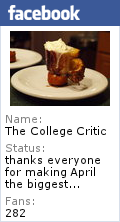Although I grew up during the information revolution, the Internet always scared me— interacting with strangers in shadowy electronic alleys still feels dangerous and lurid. In order to learn more about the insular New York City dining scene though, I needed to join a community of knowledgeable food lovers. Mouthfuls, a food forum, unites a group of bloggers, chefs, food professionals, and food enthusiasts. There, pseudo/semi-anonymous posters argue about the best and worst of New York eating, chastising professional restaurant critics and ignorant amateurs alike. Although minor controversies have marked my time on mouthfulsfood.com—of particular interest, a fight over my Lotus of Siam soft-opening report—discussing the food world with my compatriots has altered my outlook on food writing.
When Jessica, alias “Jesikka,” invited me to her party for mouthfuls members, I accepted with excitement. Held in conjunction with New York Bite Club, a secret dining club, the mouthfuls party offered me a chance to put physical faces with Internet avatars. Moreover, I had never patronized a secret dining club before, so this seemed like an opportunity to scratch two items off the bucket list.
With a strong menu—highlights included foie gras “nutter butters” and an ethereally rich piece of pork belly—and new friends, the Bite Club/mouthfuls party proved immensely pleasant. Specific discussion of food, milieu, and character seem inappropriate, since Bite Club represents a cloistered space for clandestine eating. A seraglio of culinary delights, Bite Club deserves a respectful nod to anonymity and discretion. Instead, a more theoretical conversation feels apropos; the intersection of an Internet meet-up and a secret dining club interests me. How do the phenomena of Internet meet-up and dining club inform each other? What congruences and discontinuities emerge from careful comparison?
Internet meet-ups force the electronic into the physical. A Manichean dichotomy of false and true, imitation and object, simulacrum and original, spiritual and corporeal, and imaginary and real characterizes the division between Internet communities and “real life.” While forums like mouthfuls provide a space for social interaction, this interaction occurs in an invisible territory, one constructed from indeterminate electronic topologies. Individuals know each other (at least before meeting in reality) as avatars, representations of the real manifested in cyberspace. Cyberspace allows the individual to construct an alternative self, a fictive subjectivity authored by (and underwritten by) the real self. Nevertheless, occupying cyberspace entails separating real subjectivity from constructed subjectivity. When members of an Internet community meet in “real life,” Internet avatars deposit in the space of the real, built up like gas suddenly transforming into solid matter. Thrust into the real, imagination becomes reality. In the process, false and true subjectivities become confounded, generating a liminal, confused social space. Fantasies are dispelled, dreams evaporate, and the physical self subordinates the alternate. Never again will the constructed self exist unadulterated in cyberspace, at least for those knowing the corporeal self. The observer must reread and reunderstand; social interactions contort to fit the new outlines of acceptable and expected behavior.
Similarly, the secret dining club forces the restaurant space into the domestic. At New York Bite Club, a restaurant emerges in someone’s home. Although defining the dining experience as a “restaurant” requires defining the characteristics of “restaurant,” this poses no insurmountable barriers. Bite Club clearly attempts to simulate a restaurant experience in the domestic, from the tasting menu format (rarely, if ever, seen in domestic food service or at dinner parties) to the hostess and service staff. Perhaps, Bite Club tries to produce a kind of hybrid restaurant and domestic space; however, this project requires extruding the restaurant space through or imposing it on the domestic template. Guests remember their location when they see the nonprofessional kitchen and various inaccuracies in recreating the restaurant experience. The evident projection of the restaurant onto the domestic raises a line of inquiry: what expectations and conventions separate the restaurant from the domestic, and how does this separation parallel the Internet’s dichotomization of subjectivity?
Restaurants offer escape from the domestic, an opportunity to leave behind domestic labor—the work of eating at home—and transfer that labor to an external work force. Consequently, the restaurant traditionally engenders a fantasy world where convention disguises labor. Service staff appear before the diner, and even occasionally the chef, but the identity of these individuals when they interact with the diner differs from “laborer.” The true labor of “cooking,” not “cheffing” hides in the kitchen. Even kitchen tours fail to unveil the labor of cooking, since restaurants usually offer these tours only when they feel confident that their disguise will remain unpenetrated. For example, at wd~50 the kitchen tour (and open kitchen) show off the line, where the work of “cheffing” occurs. The more domestic division of labor lies obfuscated in the basement and in the dark back recesses of the kitchen, where dishwashers work and prep cooks break down product. Patrons at a restaurant do not want to see domestic labor. Rather, the restaurant fantasy needs to be preserved, the hologram of glory hovering over a subterranean world of labor. Then, the diner returns home, to the world of domestic work, with an illusion of the restaurant fantasy intact.
Thus, the Internet meet-up disrupts the fantasy of constructed subjectivity like the dining club disrupts the restaurant fantasy. The imaginary materializes, assigning identity and interfering with the imagination of both self and alterity. Just as the Internet meet-up draws into question assignments of fiction and reality, the secret dining club interrogates the devaluation and denigration of domestic labor.

